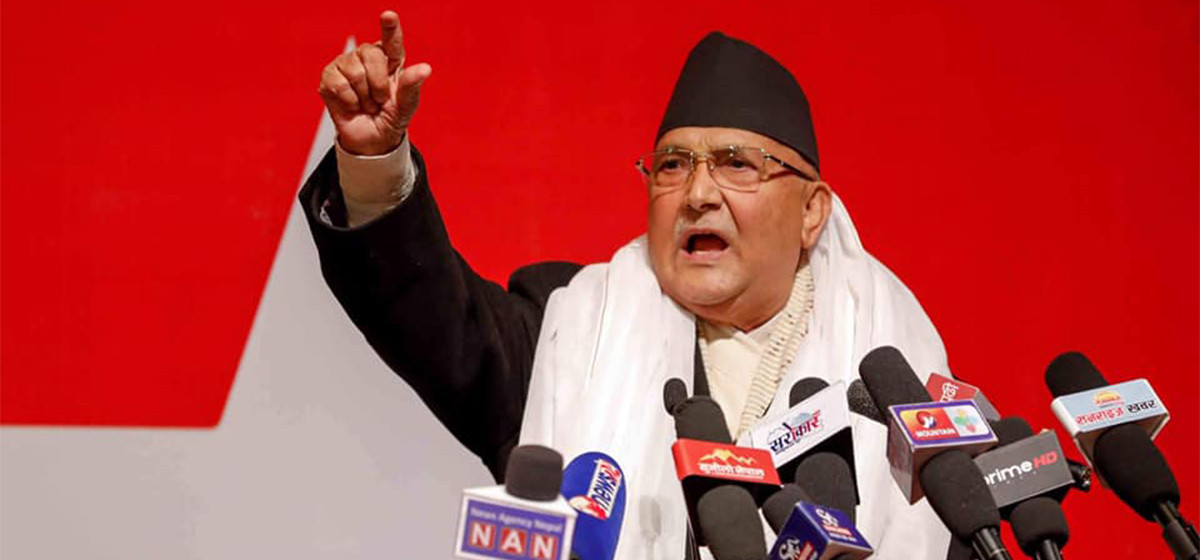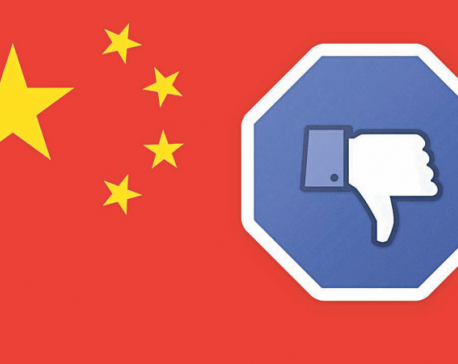
OR
Debunking the false Nepal narrative
Published On: March 24, 2021 08:50 PM NPT By: Bikash Sangraula | @SangraulaBikash

Dissolution of Parliament in December, 2020 was the consequence of a series of ill-conceived ploys by three restless former prime ministers to sabotage, oust, and bring the curtain down on the political career of the incumbent.
It would be natural for the readers of English language output of the Nepali media to be bewildered by the turn of events, where the impending political downfall of KP Sharma Oli has been announced more than once over the past two years. Nepali language media users, at least, have a wide variety of sources, including social media, and can reach their own conclusions about the facts-on-the-ground rather than relying on the prejudiced reportage that engulfs the English media landscape.
For two years after the government was formed, the political forces in opposition to Oli, mainly the members of the top-level Secretariat within his own unified NCP, concentrated on promoting what can only be called propaganda—a barrage of reportage and opinions to try to sway public opinion. When the constitutional two-year moratorium on no-confidence motions in Parliament was over, they made their move.
In a nutshell, the dissolution of Parliament in December, 2020, which was presented as proof of a dictatorially inclined Prime Minister, was the consequence of a series of ill-conceived ploys by three restless former prime ministers to sabotage, oust, and bring the curtain down on the political career of the incumbent.
![]()
Years of simmering feud in the top echelon of the now formally divided NCP, and decades of infighting in the UML, served as the backdrop to these developments. A dispiriting spectacle of political grandstanding was staged with a wide section of the media acting, for unfathomable reasons, as loudspeakers to lend legitimacy to the personal ambitions of leaders who believed that the Party should run the Government, that the prime minister is answerable to them rather than to Parliament.
If the trio led by the unreconstructed Maoist Pushpa Kamal Dahal had the kind of political heft and popular support it claimed, it would have removed Prime Minister Oli from Singha Durbar by now, sent him back on foot to Balkot as vowed, and met its ambition of capturing the presidency, Singha Durbar, as well as Dhumbarahi.
Seeing the dangers as the no-confidence motion was finally being readied to be placed before Speaker Agni Sapkota, the murder-accused who places loyalty to Pushpa Kamal Dahal before all else, PM Oli moved sine die to dissolve Parliament. While some saw this as regression (pratigaman) akin to King Gyanendra’s coup in 2005 and his father Mahendra’s in 1960, the fact was that election dates had been announced.
Besides, the Constitutional Bench of the Supreme Court had been announced and there was no way that the Prime Minister could have defied whatever decision the five-member Bench handed down. There was certainly no clear need with the facts and issues on the table, as far as the public at large was concerned, for a ‘people’s movement’ as in 1990 or 2006.
The Supreme Court under Chief Justice Cholendra Shumsher Rana it was that decided the direction of the polity. First came the Constitutional Bench’s decision to declare PM Oli’s dissolution null and void, and to restore Parliament. But before the jubilant opponents of the Prime Minster had been able to sit down to strategize their next move, the Supreme Court judgement rescinding the NCP unification redefined the entire political landscape.
With the parties going back to their situation as of the polls of 2017 autumn, Dahal was forced to part ways with his allies Madhav Kumar Nepal and Jhalanath Khanal, and he dropped from being Co-Chair of the largest party in Parliament to being the sole chair of a severely diminished Maoist Centre party, and third on the totem pole.
A month after Parliament was reinstated and long after his eclipse had been announced with glee, Oli, who was singled out by his critics as the single biggest infection afflicting the nation, still enjoys the confidence of the Maoist Centre. The no-confidence motion moved on December 20, 2020 registered hours after the Lower House dissolution, but given a forged timing by Speaker Sapkota, has been abandoned by Dahal and Co. As of this writing, no new no-confidence motion seems to be in the planning.
Oli’s associates-turned-foes had failed miserably in coming up with an alternative dispensation they had promised, and they lost the little trust they had retained among the public. Their argument that Parliament’s restoration would resolve the political arena turned out to be the result of hubris not backed by capacity, and the stuntmen are now nursing their self-inflicted wounds.
It is interesting to note that over the past three months of upheaval, the KP Oli faction of the NCP did not oust anyone from the party. Whereas the Dahal-Nepal combine was busy filling party positions, while ostensibly ousting Oli from the party. Today, Dahal’s lieutenants Nepal and Khanal are living in utter embarrassment, as seen in their cartwheeling public positions and visages on television. At least temporarily they have been left without a political roof over their heads, and quite dependent on what Oli recommends for them.
The spat this time was public, ugly, and very damaging to all members of the trio. While the ever-pliant media sought to create a scenario where Madhav Kumar Nepal was the main loser, without doubt the political fortune had nose-dived the most for Pushpa Kamal Dahal. Not only was he now the member of the much smaller Maoist Centre, he had lost a whole slice of the party leadership to the Oli camp, including Home Minister Ram Bahadur Thapa Badal as well as Far-West leader Lekh Raj Bhatta, and Top Bahadur Rayamajhi.
Interestingly, during this time of political churning, a section of media commentators preferred to highlight the role of Maoist former Prime Minister Baburam Bhattarai, even though he does not figure in any political equation.
Bewildering scenario
Making sense of what seemed like an abrupt dissolution of the Lower House turned out to be difficult for the Kathmandu intelligentsia. Explaining it to readers and viewers here and abroad proved even harder. It was perhaps the greyness of contemporary Nepali politics that pushed some trusted information outlets to churn out facile, lopsided reportage in the immediate aftermath of the dissolution.
Those who wish for a credible and independent press have waited, with bated breath, for the emergence of evidence that the inadequate and problematic coverage of the dissolution was an aberration, and that the fracture of the trust between the public and the mass media would be repaired. The wait continues to this day.
Not able to follow the behind-the-curtain shenanigans that have made the mainstream outlets so wrong in their reportage as well as opinions, the consuming public within and outside the country remain bewildered. The vicious cycle of parroting the misleading and dangerous narrative crafted by a handful of greedy politicians and keeping the public at home and watchers abroad in the dark is reminiscent of the time of the Indian Blockade of 2015. Indeed, it is nearly the same media individuals who genuflected during the time of the blockade that were hoisting the Dahal-Nepal flag as the victors even as they were going down in flames.
Attack on institutions
Nepali citizens are familiar with Dahal’s strategy of weakening institutions in the hope of reaping financial, institutional, and political benefits amidst the ensuing confusion. Therefore, despite being bombarded by news and views that attempted—and continue to attempt—to portray Dahal as the new vanguard of democracy and rule of law, the decisive mass didn’t budge.
To be sure, Dahal and his lieutenants did succeed in throwing some dirt at institutions, including Shital Niwas, the Supreme Court, and the military. Questions were raised about President Bidya Devi Bhandari’s ‘immediate approval’ of Oli’s recommendation to dissolve Parliament, although it takes only one look at Article 66 of the Constitution to be convinced that she could not have done otherwise. Indeed, the President is not given leeway by the new Constitution to hold consultations, a privilege that was available to and exercised under the Interim Constitution by the first President Ram Baran Yadav.
In February, the nation’s oldest institution—Nepal Army—was also pulled into controversy for carrying out a drill of armed personnel carriers in Kathmandu. These vehicles, painted white and used for Nepal’s UN peace-keeping operations, had to be driven beyond their bases and the Army had provided adequate notices and carried out the drive at nighttime. But this did not deter commentators referring darkly to an impending coup, and even announcing that the APCs were ‘tanks’.
The Supreme Court’s verdict of reinstating the Lower House was celebrated by Dahal and Co and commentators lauded the justices for their wisdom, sagacity, and impartiality amidst the polarized landscape. When the second judicial bombshell hit, essentially breaking up the NCP into its Maoist and UML factions, those very commentators could hardly turn around and accuse the Supreme Court of bias and partiality. Nevertheless, accusations surfaced from some quarters.
On the whole, the work of the prejudiced media projectors over the last two months has been to create a false narrative about what is happening, with a complete disregard to the fact that the Supreme Court was engaged with the controversies and nobody was about to challenge its verdict, whichever way it went. As a result, one could even blame the scare-mongers for some of the economic downturn that the country has seen, as investors and the public at large lost confidence.
Such a dire scenario was created that Nepal-watchers and editors abroad would ask when a state of emergency would be declared by PM Oli and whether the military would step in to support the impending putsch. “Is Nepal becoming another Myanmar?” one Nepal-watcher asked overwhelmed by the rapid developments. Little would he know that on the ground, the public was not panicking despite the media harangues.
Plotters of the melodrama
The plotters of the Nepal Melodrama had calculated that it would be easy to mislead a population distressed and exhausted by the Covid-19 pandemic, which has wrecked livelihoods and destroyed prospects of millions of citizens. Adding political anxiety to the recipe, it was believed, would break the people’s will, which, in turn would lead to a movement to oust Oli and hoist Dahal, who was proposed as Prime Minister in the December 20 no-confidence motion.
A section of the media, pliant for reasons that will have to be unearthed in the coming days, was manipulated to project iron-willed Oli as an autocrat in the making and Dahal, whose ‘people’s war’ cost the nation almost six times the lives Covid-19 has claimed so far, as the new champion of peace, democracy and constitutionalism. None of the media projectors were caring of the incongruity between Dahal’s attempted new branding and his taking ‘responsibility’ for 5,000 of the 17,000 killed during the decade-long conflict.
On the whole, Nepal was fortunate that the false narrative of Dahal as the national savior found little takers outside the circle of Kathmandu ‘opinion-makers’. The brashly announced ‘third people’s movement’ against the constitutional system and elected government was just not forthcoming.
You May Like This

Media Society condemns interim order
KATHMANDU, Feb 26: Nepal Media Society has condemned the interim order issued by the Supreme Court to the Press Council... Read More...

Respect media’s right to political ad: Nepal Media Society to govt
KATHMANDU, Nov 30: Nepal Media Society, the umbrella organization of private publications and Television Broadcasters Nepal (TBN), has urged the... Read More...

China limits online media to publish news sourced from social media
China’s internet regulator will launch a crackdown on the reporting of news gathered from social media, as part of what... Read More...







Just In
- NRB to provide collateral-free loans to foreign employment seekers
- NEB to publish Grade 12 results next week
- Body handover begins; Relatives remain dissatisfied with insurance, compensation amount
- NC defers its plan to join Koshi govt
- NRB to review microfinance loan interest rate
- 134 dead in floods and landslides since onset of monsoon this year
- Mahakali Irrigation Project sees only 22 percent physical progress in 18 years
- Singapore now holds world's most powerful passport; Nepal stays at 98th












Leave A Comment